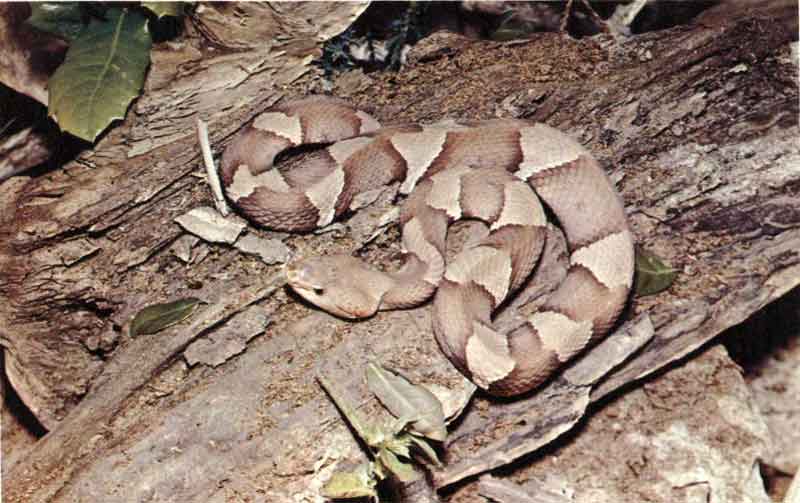
Superregnum: Eukaryota
Regnum: Animalia
Subregnum: Eumetazoa
Cladus: Bilateria
Cladus: Nephrozoa
Superphylum: Deuterostomia
Phylum: Chordata
Subphylum: Vertebrata
Infraphylum: Gnathostomata
Superclassis: Tetrapoda
Cladus: Reptiliomorpha
Cladus: Amniota
Classis: Reptilia
Cladus: Eureptilia
Cladus: Romeriida
Subclassis: Diapsida
Cladus: Sauria
Infraclassis: Lepidosauromorpha
Superordo: Lepidosauria
Ordo: Squamata
Subordo: Serpentes
Infraordo: Caenophidia
Superfamilia: Viperoidea
Familia: Viperidae
Subfamilia: Crotalinae
Genus: Agkistrodon
Species: Agkistrodon laticinctus
Name
Agkistrodon laticinctus (Gloyd & Conat, 1934)
Holotype: UMMZ 75599, adult ♂, collected by W.A. Bevan and R.F. Harvey in October 1933.
Type species: “26 miles northwest of San Antonio, Bexar County, Texas”.
Combinations
Agkistrodon mokasen laticinctus — Gloyd & Conant, 1943: 156 [original combination]
Agkistrodon laticinctus — Burbrink & Guiher, 2015: 17 [subsequent combination, elevate to species]
References
Primary references
Gloyd, H.K. & Conant, R. 1934. The broad-banded copperhead, a new subspecies of Agkistrodon mokasen. Occasional Papers of the Museum of Zoology, University of Michigan 283: 1–6. hdl: 2027.42/56722 Open access Reference page.
Burbrink, F.T. & Guiher, T.J. 2015. Considering gene flow when using coalescent methods to delimit lineages of North American pitvipers of the genus Agkistrodon. Zoological Journal of the Linnean Society 173(2): 505–526. DOI: 10.1111/zoj.12211 Open access Reference page.
Links
Uetz, P. & Hallermann, J. 2022. Agkistrodon laticinctus. The Reptile Database. Accessed on 21 May 2021.
Vernacular names
English: Broad-banded Copperhead
Agkistrodon laticinctus is a venomous pit viper species,[3] formerly considered a subspecies[4] of Agkistrodon contortrix, which is found in the southern United States, from Kansas, through Oklahoma and throughout central Texas.
Description
Head of a broad-banded copperhead (Agkistrodon laticinctus)
This form is typically a light tan in color, with darker brown, wide crossbands - which gives it its common name. The actual color varies, by locality, from a red-brown, to a gray-brown. It overlaps with the southern copperhead, A. contortrix in the eastern reaches of its range, making specimens there difficult to distinguish, but generally A. contortrix has banding that narrows at the spine, creating hourglass shapes, whereas A. laticinctus has bands that do not narrow at the spine. They grow to approximately 20-36 inches (50–90 cm) in length. As juveniles, all species of Agkistrodon have a bright green-yellow color to their tail tips, believed to be used as a lure to attract prey items to approach within striking range. The color fades to a grey or brown at about a year of age.
Common names
Common names for this species include: broad-banded copperhead, copperhead moccasin, copperhead snake, dry-land moccasin, highland moccasin, moccasin, rattlesnake pilot, red eye, Texas copperhead and thunder snake.[2]
Geographic range
Agkistrodon laticinctus is known to populate the region between 97 degrees and 99 degrees west longitude, from Central Texas north to the southern border of Kansas and Oklahoma.[2]
Behavior
Secretive and nocturnal, it prefers lightly wooded habitats, typically with a good amount of ground debris for cover, not far from a permanent water source. It typically avoids regions with a significant population of humans. It is an ambush predator, eating rodents, birds, lizards, anurans, and certain insects, with juveniles in particular having a taste for various kinds of insects, such as cicadas. Wide foraging of caterpillars has also been documented in the field.[5] They are ovoviviparous, giving birth to a litter of up to eight young in the early fall.
Venom
Like most pit viper species, A. laticinctus has a hemotoxic venom, which is delivered through hinged, hollow fangs set in the front of their jaws. The fangs work like hypodermic needles, injecting the venom in a single, quick striking motion. Copperhead venom is not considered to be life-threatening to an otherwise healthy adult, but it can cause localized swelling, necrosis, and severe pain. Any bite from a venomous snake should be considered serious and medical treatment sought. There is no antivenin specifically manufactured for copperheads. However, CroFab, which makes use of the venom from the cottonmouth (Agkistrodon piscivorus), can be used in cases of a severe envenomation.
References
McDiarmid RW, Campbell JA, Touré T. 1999. Snake Species of the World: A Taxonomic and Geographic Reference, vol. 1. Herpetologists' League. 511 pp. ISBN 1-893777-00-6 (series). ISBN 1-893777-01-4 (volume).
Wright AH, Wright AA. 1957. Handbook of Snakes. Comstock Publishing Associates. (7th printing, 1985). 1105 pp. ISBN 0-8014-0463-0.
Frank T. Burbrink, Timothy J. Guiher (2014). Considering gene flow when using coalescent methods to delimit lineages of North American pitvipers of the genus Agkistrodon. Zoological Journal of the Linnean Society, December 2014. doi:10.1111/zoj.12211
"Agkistrodon laticinctus". Integrated Taxonomic Information System. Retrieved 15 May 2007.
Salmon, G. T., H. W. Greene, and T. Dimler. "Biology of the Pitvipers 2." Biology of the Pitvipers 2. Department of Ecology and Evolutionary Biology, Cornell University, Ithaca, NY, USA, 4–7 June 2014. Web. 19 July 2014.
Retrieved from "http://en.wikipedia.org/"
All text is available under the terms of the GNU Free Documentation License

